Impact of CO2 quota allocation to new entrants in the electricity market
5 Model analyses
- 5.1 Modelling tool
- 5.2 Key assumptions
- 5.3 Welfare-economic losses
- 5.4 Investments in electricity generation capacity
- 5.5 Impact on electricity prices
- 5.6 Emitted CO2
- 5.7 Additional simulations
- 6 % discount rate
To analyse whether the hypotheses presented in the previous sections have merit, a number of quantitative simulations have been performed using the Balmorel model.
The Balmorel model covers the electricity and district heating sector of the Nordic countries and Germany. With the model it is possible to determine how investments and production patterns will develop depending on the allocation conditions for new plants.
Two basis simulations are compared: a simulation with allocation to new entrants and a reference simulation without new entrant allocation. In addition sensitivity analyses are made examining the impacts of combining the CO2-emissions trading scheme with renewable energy targets and varying key parameters such as the CO2-price and investors rate of return.
5.1 Modelling tool
The Balmorel[6] model is a dynamic partial equilibrium model which simulates welfare-economic optimal dispatch of generation capacity, consumption, transmission as well as performing investments in generation technology endogenously.
In the model the Nordic countries are divided into 10 areas on the electricity side, separated by transmission links. Finland is one area, Norway consists of four areas, Sweden of three, and Denmark of two areas. The German system is divided into three areas.
The Balmorel model is among others used by the Danish Transmission System Operator - Energinet.dk, the consulting group COWI, the Risø National Laboratory · Technical University of Denmark – DTU, Informatics and Mathematical Modelling at the Technical University of Denmark and EA Energy Analyses.
Studies, which have been carried out with the model, include analyses of the benefits of the Great Belt connection by Elkraft System (2005) (Transmission System Operator of Eastern Denmark until 1.1.2005), analyses of the NorNed cable for NVE (by COWI and Ramløse-EDB), simulations and analyses of the electricity markets in Poland and the Baltic countries (in connection with the project Common Baltic Electricity Market) (Eesti Energia et al., 2005) and an analysis of introducing 50 per cent wind power in the Danish electricity system (Ea Energianalyse, 2007).
The model and key model assumptions are described in more detail in Appendix A.
5.2 Key assumptions
The simulations in the present study assume competitive markets and perfect foresight over a one year horizon.
Investments are assumed to take place in an electricity market with no subsidies or other incentives except for the CO2-scheme. The annualised costs are based on a specified discount rate. In the base calculations a discount rate of 10 % is used. This represents the investor’s demand for rate of return of the investment.
Fuel prices in the reference analyses are based on the latest projection by the IEA (World Energy Outlook 2006) and a CO2-price of 20 euro/tonne is applied.
| EURO/GJ | Light oil | Fuel oil | Coal | Natural gas | Straw | Wood |
| 2007 | 9.0 | 5.0 | 2.0 | 4.9 | 4.5 | 4.4 |
| 2010 | 9.1 | 5.1 | 1.8 | 5.0 | 4.5 | 4.4 |
| 2015 | 9.0 | 5.0 | 1.8 | 5.0 | 4.5 | 4.4 |
| 2020 | 8.8 | 4.9 | 1.8 | 5.1 | 4.5 | 4.4 |
Table 8: Fuel prices used in the model (based on the IEA World Energy Outlook 2006). Gas prices in Denmark and Finland are as depicted in the table, whereas they are 10 pct. lower in Norway and 10 pct. higher in Sweden. The prices of light oil and fuel oil correspond to a crude oil price of 48 $/bbl in 2015.
Due to ageing three per cent of thermal power capacity is expected to be decommissioned per annum. A specific assumption on generation capacity in Germany concerns the nuclear phase out programme which is assumed to be implemented causing a gradual phase out of all nuclear capacity in the period to 2022.
In the model new investment can be made in coal, gas, wind, biomass and nuclear technologies. However, investments in new nuclear plants are only allowed to take place in Finland, due to the existing policies (the recent change of policy in Sweden towards a more positive approach to nuclear power has not been taken into account). Carbon capture and storage technologies are not included in the analyses.
With respect to free allocation to new entrants, it is assumed that.
- Allocation is based on the principles in the National Allocation Plans for 2005-7. Background: EU decisions are not available for all NAPs for 2008-2012.
- Investors expect free allocations to new entrants over a 10 year period. Background: Some countries have not provided information on the length of allocation. For reasons of simplification we assume that all countries will allocate quotas for two subsequent Kyoto-periods (2*5 years). The German NAP specifies the allocation period to 14 years, but this guarantee has been questioned by the EU commission.
- To determine the size of allocations and expected electricity generation from new plants is 6000 full load hours per annum assuming that the new power plants will provide base-load power. CHP plants are expected to generate 4000 full load hours of heat per annum. The actual resulting operations within the model are likely to defer from these, but as updating is not employed this does not affect allocations.
- The value of the free allocation is based on the actual value of CO2 emissions certificates in the year of investment. The value of future allocations are reduced using a discount rate of 10 % per annum
- No upper limit for quantity of allocations for new plants each year (i.e. no limit to the new entrant reserves in the countries concerned)
- Norway applies the same rules as Sweden (no data was available for Norway for 2005-7).
For a further description of the model assumptions we refer to the Background paper on modelling tool and data assumptions (Appendix A).
5.3 Welfare-economic losses
The Balmorel model has the capacity to quantify welfare-economic losses and gains with respect to alternative policies. For the purpose of these analyses the definition of welfare-economic losses (negative) and gains (positive) are attributed to changes in sum of the economy of all stakeholders.
The relevant stakeholders are
- Consumers
- Producers
- Grid owners
- States
In these simulations a simple level playing field is employed as the benchmark. Hereby, country specific tax regimes and subsidies are disregarded. In the case with free allocations to new entrants these allocations are assumed to be drawn from the pool of free allocations to producers as a whole. Thereby the net-gains/losses born by states are zero by construction.
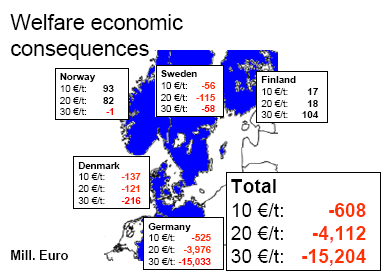
Figure 20: Geographical distribution of Welfare-economic losses and gains. Gains are denoted as positive while losses are negative. Overall the system is subject to a loss of approximately 4.1 billion euros at a CO2-price of 20 euro/tonne. The results show that the countries with the highest degree of allocation to new production units incur the greatest losses.
Figure 20 provides an overview of the simulation results. The figure shows the difference is the welfare-economy between scenarios with and without free allocation for new entrants. The welfare-economic losses are approximately 4.1 billion EUROs in real terms, in the baseline 20 euro/tonne setting, or approximately 25 per cent of the total investments in the electricity sector over period 2006-2022. The losses rise with the CO2-price as the market distortion is proportionate with the value of emissions allowances.
Losses are disproportionately distributed across among groups. Perhaps contrary to some expectations, the group of producers bears the brunt of the economic distortion (see Table 9). There are two reasons for this.
1. Producers tend to profit from operating in a sector characterised by underinvestment. Conversely in an over invested market competition will drive down prices and profits.
2. The group of producers comprises both new and existing production capacity. Since allocations to new entrants are assumed to be deducted from available allocations to producers in general, free allocations to new entrants do not generate additional revenue for the group as a whole.
Consumers, on the other hand, benefit from new entrant allocation because more investments are made in the power capacity, thereby causing lower electricity prices.
Because of its favourable allocation rules for new entrants Germany bears the greatest economic consequences of all the countries sustaining a total loss of 4 bill. euro.
Total economic consequences for Finland and Norway are positive because these countries are in these simulations net importers of electricity and therefore benefit from the decreasing electricity prices, which are a result of allocating quotas to new entrants.
| Mio. EURO | DENMARK | FINLAND | GERMANY | NORWAY | SWEDEN | TOTAL |
| Producer | -1,003 | -1,218 | -33,262 | -2,385 | -2,712 | -40,579 |
| Consumers | 954 | 1,387 | 29,535 | 2,510 | 2,995 | 37,381 |
| Grid owners | -72 | -151 | -249 | -43 | -398 | -915 |
| Total | -121 | 18 | -3,976 | 82 | -115 | -4,112 |
Table 9: Welfare-economic losses and gains distributed on stakeholders. Assumed CO2-price: 20 euro/tonne. The results show that electricity producers suffer significant losses whereas consumers benefit from allocation to new entrants. This is because new entrant allocation produces more investments in the power sector and thereby lowers electricity prices. Economic consequences over the period 2006-2022 have been reduced to 2006 (net present value) using a discount rate of 10 %.
5.4 Investments in electricity generation capacity
Comparing the two main scenarios, i.e. the Reference case and the New Entrants Allocation case the key difference is the incentive for investment. By the introduction of free CO2-quota allocation, the cost of investment for certain technologies is reduced and thereby competition between technologies is skewed on the long-term, as described in section 4.2. Meanwhile the short-term incentives – the dispatching of capacity in the electricity spot market - remain the same. Hereby, the explanations for the welfare-economic distortions, described in section 5.3, are found in the investment depictions below.
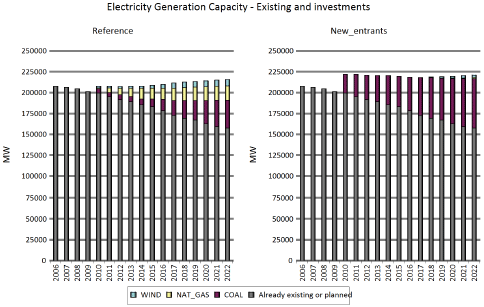
Figure 21: This figure illustrates how investments in new-generation technology replaces or supplements existing technology in the two scenarios. While the reference scenario features an investment mix of coal, gas and wind power, the case with free quotas for new entrants is dominated by coal-fired electricity generation capacity.
Two trends are evident from Figure 21 above.
- While there is a mixture of investments coal, natural gas and wind power in the Reference scenario, coal power is the predominant technological choice when free allocations are given to new entrants.
- The total capacity is somewhat higher in the scenario with an investment subsidy in the form of free CO2-allowances.
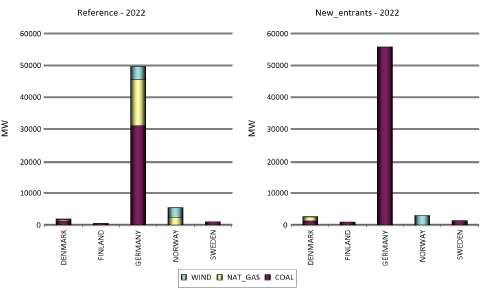
Figure 22: This figure shows cumulated investments in the final year of the simulation (2022) distributed on countries.
Among the countries simulated it is clear that changes in Germany are the most notable. Germany is by far the largest in terms of electricity generation and consumption. Secondly, the nuclear phase out, along with a gradual decommissioning of fossil fuel based thermal power, generates a large demand for investments in new generation units. Thirdly, the impact of the free allocations to new entrants policy is most evident here. The diversity of investments in the Reference scenario is completely absent in the New entrants scenario.
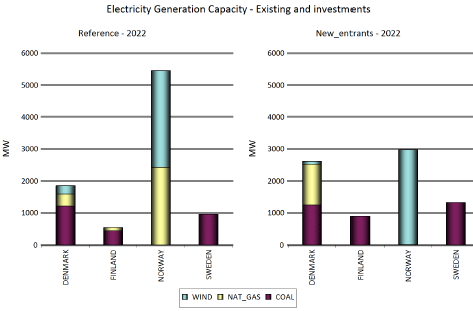
Figure 23: This figure shows cumulated investments as Figure 22 but without Germany. Hereby investments in the other countries can be examined.
The effects of free CO2 allocation to new entrants in the Nordic countries are more easily examined on Figure 23. Additional capacity in Germany, Denmark, Finland and Sweden, removes the necessity of over 2 GW of gas fired generation capacity in Norway. In Denmark investments in wind power are reduced and investments in gas power are increased. Finland increases investments in coal fired capacity and do not invest in gas fired capacity as in the reference scenario. Sweden increases investments in coal fired capacity.
Below shows the value of the CO2-quotas allocated to new entrants.
| Country | Value (mill. €): |
| Denmark | 283 |
| Finland | 195 |
| Germany | 18,970 |
| Norway | 1 |
| Sweden | 116 |
Table 10: Value of allocations to new entrants. Allocations over the period 2006-2022 have been reduced to 2006 (net present value) using a discount rate of 10 % .
The total value of allocations is about 4-5 times the loss sustained by the economy as a whole.
5.5 Impact on electricity prices
Free allocations of emissions certificates to new generation units have no effect on the short-term order of dispatch. Therefore, in the short-term free allocations should not affect electricity prices. This was explained in section 4.1. The presence of additional modern generation capacity as a product of investments does however impact electricity prices. Overcapacity reduces the number of hours where expensive and inefficient peak load facilities need to be in operation.
This effect is most evident in Germany, where the largest number of additional investments was undertaken. Second in line are Denmark and Sweden, Germany’s immediate neighbours.
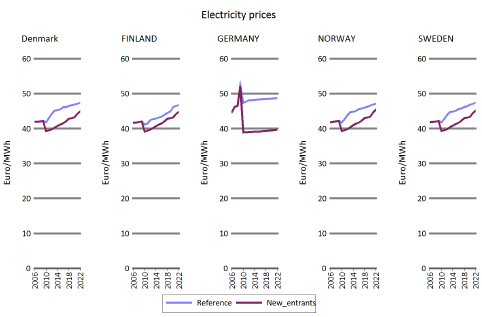
Figure 24: This figure illustrates how the additional capacity affects electricity prices. Price averages are weighted by local consumption representing the average prices as perceived by the electricity consumer.
There is in both scenarios an initial increase in prices followed by a drop in 2010. This occurs due to the assumption of gradual decommissioning of older units, the projected increase in electricity demand, and the lead-time in construction ensuring that the first new entrants enter the market in 2010. Subsequently, prices increase gradually in all countries, following the projected development in fuel prices. In the scenario with free allocations, the gradient of price increase is higher in the countries where a local tightening of the capacity balance occurs, since investments take place in other countries. Thereby, Finland sees the highest price increase gradient and Germany the lowest.
5.6 Emitted CO2
The development in CO2 emissions from the electricity sector in both simulations are compared with emissions in absence of a CO2 limiting scheme. The central forecast indicates that the level of emissions would rise. This growth can be attributed to an assumed increase in electricity demand over the model horizon, as well as the large scale decommissioning of Germany’s nuclear generation capacity.
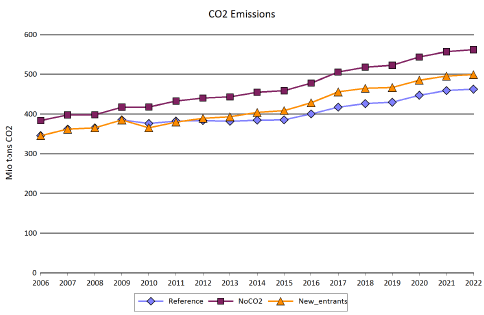
Figure 25: Annual CO2-emissions from electricity generation and district heating.
As the simulated region features a considerable amount of combined heat and power generation (CHP) the CO2-emissions, depicted on Figure 25, result from generation of both electricity and district heating. The NoCO2-label refers to the above mentioned case where no CO2 limiting incentives are present in the market i.e. a CO2 price of zero.
Table 11: CO2-emissions in 2022 in three scenarios
| Scenario | CO2-emissions (megaton/year) |
CO2-reduction from emissions trading (megaton/year) |
| No CO2 limiting incentives | 562 | 0 |
| CO2 regime | 462 | 100 |
| CO2 regime w. quota allocation to new units | 499 | 63 |
A number of observations can be made on the results documented in Figure 25 and Table 11.
- Free allocation to new units reduces the environmental benefits of the EU ETS from the electricity sector from an annual reduction of 100 megatons by 2022 to only 63. In other words the long-term annual reduction in absolute terms is almost halved by free allocations to new entrants.
- Even in the situation with no allocation to new entrants CO2 levels from the electricity sector rise over the simulated period.
The explanation for the later is a combination of several factors:
- With the phase out of nuclear power in Germany a CO2 neutral form of electricity generation needs to be substituted, and in all scenarios fossil fuel based technologies are prevalent
- The assumed price level of CO2-emissions permits is neither sufficient to introduce large amount of renewable energy nor to bring about a shift from coal to gas base load generation technologies.
Moreover, assumed fuel price also impact investment patterns significantly. In this study fuel prices are based on the IEA World Energy Outlook 2006 as explained previously. If the price ratio between coal and gas develop to the benefit of gas this could change investment and production patterns considerably.
5.7 Additional simulations
In addition to the two simulations described above, a number of additional simulations have been performed.
• Impact of free allocation to new entrants in a scenario where CO2-emissions were capped at the 2006 level (in this case the CO2-price is computed endogenously by the model)
• Impact of free allocation to new entrants in a scenario with renewable energy target for electricity generation
• Impact of changing investors’ rate of return to 6 % (as opposed to 10 %).
A scenario with a carbon price of zero (i.e. no CO2 restrictions) was performed to put some perspective on the level of CO2-emissions as has previously been presented. Also, in light of the high level of political interest in renewable electricity generation, a renewable energy target scenario is investigated.
5.7.1 Maintaining CO2-emissions at current levels
An additional simulation has been prepared to examine what CO2-price would be required to maintain emissions in the modelling area at the 2006 level.
To study this, an emissions cap for the simulated system is introduced in the model, limiting total annual CO2-emissions to 345.4 megatons/year. The price of CO2 allowances is then calculated as an output of the model. The results appear from Figure 26. In the long term a CO2-price of app. 25-30 euro/tonne is required to keep emissions under control.
There are no good options for a marginal reduction in emissions in the system other than investments in more CO2 friendly generation technologies. The main measure to curb emission is a shift from coal to gas technologies. At CO2-prices of 20-25 euro/tonne coal-fired technologies seem to have lost their attractiveness all together (se Figure 27, left).
When the same level of CO2-prices are applied in a simulation where investors in new generation units receive free allocations coal becomes an attractive fuel again and approximately 50 per cent of gas power is replaced by coal power (Figure 27, right)
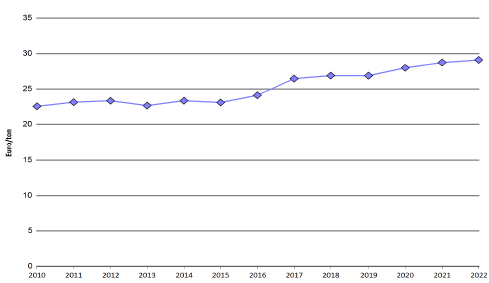
Figure 26: CO2-price with a fixed emissions cap. The steep rise in price from 2006-2009 and subsequent drop in price level is caused by the assumption that no endogenous investments are permitted by the model until the year 2010.
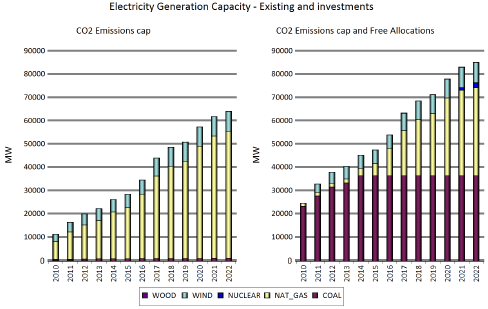
Figure 27: Again the investments are depicted. On the left, an emissions cap has been applied and thus efficient abatement results in a CO2-price for the system (as per Figure 26). On the right, investors in new generation units receive free allocations priced according to the first case.
Free allocation to new entrants effectively increases the CO2-price in a capped system because fossil fuel technologies become cheaper. Thereby a higher CO2-price is needed to stimulate investments in technologies with low or no CO2-emissions.
Therefore it has been attempted to make additional iterations of the above-mentioned simulation with a CO2-cap to examine the consequences of new entrant allocation on the CO2-price.
The iteration steps are described below:
1. Simulation with cap on CO2 => CO2-price deduced by the model
2. Simulation that include new entrant investment subsidy based on the above-mentioned CO2-price => higher CO2 price
3. Simulation that include new entrant investment subsidy based on the above-mentioned higher CO2-price => even higher CO2 price
4. Etc.
The result after only one iteration is a CO2-price of app. 40 EURO/tonne in 2018. However, at this level the reduced value of the allowances to new entrants increases beyond the investment costs of a new power plant, and as a consequence the model generates an excessive amount of generation capacity. Therefore it does not make sense to make further iterations.
These excessive investments are of course not likely to take place in the real world, where investors are likely to have a more holistic approach to new investments and authorities may interfere. Moreover, this calculation does not take into account that quotas can be acquired from other sectors and from JI/CDM, which will contribute to keeping down the price of carbon.
If we assume that allocation to new entrants will cause the CO2 price to increase from 20 euro/tonne in the reference situation to 25 euro/tonne, this will increase the total socio-economic loss in the modelling area dramatically from €4.1 bn. to € 25.8 bn (comparison of the reference scenario with a CO2-price of 20 euro/tonne and no allocation to new entrants with a situation with a CO2-price of 25 euro/tonne and allocation to new entrants) If the carbon price increases further to 30 euro/tonne the loss is €46.2 bn. and at 35 euro/tonne to €67.6 bn. .This is illustrated in Figure 28 below, where the impacts are also distributed on the countries in the modelling area.
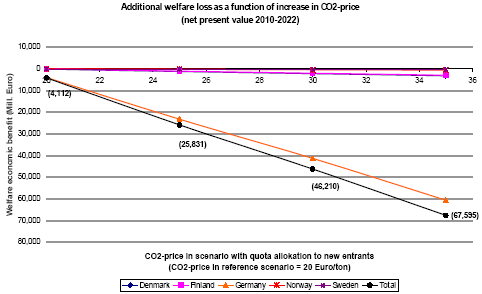
Figure 28: This figure illustrates the welfare economic loss when assuming a CO2 price of 20 euro/tonne in the reference scenario, while CO2 prices are 20, 25, 30 and 25 euro/tonne in the scenario with free allocation to new entrants.
This shows that the possible welfare-economic losses may become significantly higher than €4.1 bn if new entrant allocation affects the CO2-price as the simulations indicate.
5.7.2 Target for penetration of renewables
At this point it is evident that free allocations to new generation units based on the current national allocation plans, strengthens the position of carbon intensive generation technology. An interesting question is how this policy would interact with a possible target for penetration of renewables. To shed light on this two additional simulations have been undertaken.
- The reference scenario is modified to include a minimum percentage of annual electricity generation which must be renewable.
- Secondly this target is applied in conjunction with free allocation to new entrants.
The target percentage ratio for renewable generation is introduced from 2010 at a level of 30per cent - corresponding roughly to the renewable energy ratio in 2010 if no new measures are taken. This target is subsequently increased by 1per cent-point per year to reach 42per cent in 2022.
Figure 29 shows the cumulated investments in the original reference (no RE-target, no free allocation to new entrants), in the case with a renewable target (but no free allocation to new entrants) and in the situation with a renewable energy target and free allocation to new entrants.
The investments in renewable energy capacity are almost identical in the two simulations with renewable energy targets. However, with allocation to new entrants the coal share of fossil fuel capacity increases from app. 60 % to 100 %, at the expense of investments in gas power capacity (reduced from 40 % to 0 %). Moreover, total investments in non-renewable energy plants increase from 37,000 MW to 45,000 MW when new entrant allocation is included.
The majority of RE-investments are made in wind power capacity and towards the end of the period in plants fired with biomass (wood). The shift from wind to biomass reflects that constraints have been implemented in the model on total off- and onshore wind power capacity (physical planning constraints). As the potentials for relatively cheap wind power are used the model invests in biomass capacity.
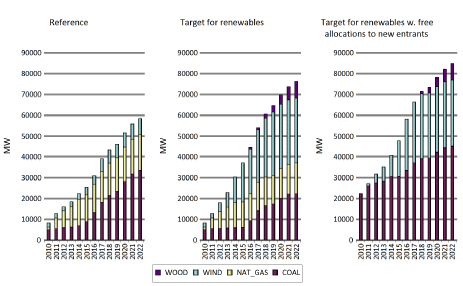
Figure 29: Cumulated investments in the original reference (no RE-target, no free allocation to new entrants), in the case with a renewable target (but no free allocation to new entrants) and in the situation with a renewable energy target and free allocation to new entrants. CO2-price: 20 euro/tonne.
Because of the subsidy to fossil fired plants through the allocation of free quotas to new plants the subsidy for renewable energy plants would also have to be increased to ensure compliance with the RE targets. This is depicted in Figure 30 showing the subsidy which would have to be paid to the marginal renewable generation unit with and without allocation to new entrants.
In both situations the marginal subsidy gradually increases as the most cost-efficient renewable energy technologies are put into play (from on-shore wind power to off-shore wind and biomass). In 2022 the required RE-subsidy is almost 60 % higher in the case with allocation to new entrants, rising from 14 euro/MWh to 22.5 euro/MWh.
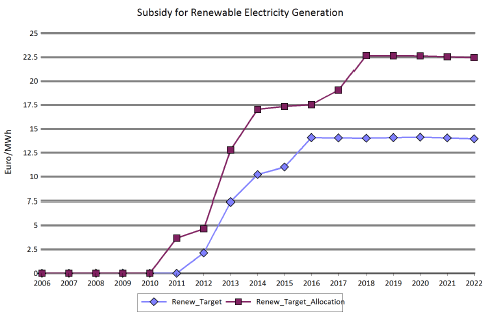
Figure 30: the needed subsidy for the marginal renewable generation unit with and without allocation to new entrants. It could also be interpreted as the expected costs of green certificates if a Green Certificate market was established. The renewable energy target is introduced in 2010.
5.8 6 % discount rate
Changing the investor rate of return and the discount rate to 6 % does not affect the welfare-economic loss of allocation significantly. Assuming a CO2-price of 20 euro/tonne the total loss of new entrant allocation is 4,213 million Euro, when reduced to 2006 (net present value). This should be compared to a loss of 4,112 million Euro when discounting with a rate of 10 %, as it was done in the basis simulation.
Footnotes
[6] The Balmorel model is an open source model. The full program code as well as a functional dataset describing the Nordic region and descriptions of various applications can be found on the Balmorel project homepage at www.Balmorel.com.
Version 1.0 June 2007, © Danish Environmental Protection Agency